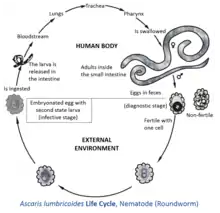Ascaris
Ascaris is a genus of parasitic nematode worms known as the "small intestinal roundworms", which is a type of parasitic worm.[1] One species, Ascaris lumbricoides, affects humans and causes the disease ascariasis. Another species, Ascaris suum, typically infects pigs. Parascaris equorum, the equine roundworm, is also commonly called an "Ascarid".[2]
| Ascaris | |
|---|---|
 | |
| Adult female | |
| Scientific classification | |
| Kingdom: | Animalia |
| Phylum: | Nematoda |
| Class: | Chromadorea |
| Order: | Ascaridida |
| Family: | Ascarididae |
| Genus: | Ascaris Linnaeus, 1758 |
| Species | |
| |

Their eggs are deposited in feces and soil. Plants with the eggs on them infect any organism that consumes them.[3] A. lumbricoides is the largest intestinal roundworm and is the most common helminth infection of humans worldwide. Infestation can cause morbidity by compromising nutritional status,[4] affecting cognitive processes,[5] inducing tissue reactions such as granuloma to larval stages, and by causing intestinal obstruction, which can be fatal.
Morphology
- Adult: cylindrical shape, creamy white or pinkish in color
- Male: average 15–30 cm (6-12 inches) and is more slender than female
- Female: average 20–35 cm (8-14 inches) in length
The body is long, cylindrical, and fusiform (pointed at both the ends). The body wall is composed of cuticle, epidermis and musculature. There is a pseudocoelom. Respiration is by simple diffusion. The nervous system consists of a nerve ring and many longitudinal nerve cords. Reproduction is exclusively sexual, and males are usually shorter than females.
Defense mechanism
As part of the parasite defense strategy, Ascaris roundworms secrete a series of inhibitors to target digestive and immune-related host proteases, which include pepsin, trypsin, chymotrypsin/elastase, cathepsins, and metallocarboxypeptidases (MCPs). Ascaris species inhibit MCPs by releasing an enzyme known as Ascaris carboxypeptidase inhibitor (ACI). This enzyme binds to the active site of MCP and blocks the cleavage of its own proteins by the host MCP.[6] Similarly, they inhibit trypsin by releasing the protein Ascaris Trypsin Inhibitor (pdb 1ATA,https://www.rcsb.org/structure/1ATA 1ATB)[7]
Evolution
Ascaris has been present in humans for at least several thousand years, as evidenced by Ascaris eggs found in paleofeces and in the intestines of mummified humans.[8]
History
A. lumbricoides was originally called Lumbricus teres and was first described in detail by Edward Tyson in 1683.[9] The genus Ascaris was originally described as the genus for Ascaris lumbricoides by Carl Linnaeus in 1758.[8] The morphologically similar Ascaris suum was described from pigs by Johann August Ephraim Goeze in 1782.[8]
Gallery
 Esophagus of an Ascaris worm
Esophagus of an Ascaris worm Ascaris cross section 40×
Ascaris cross section 40× Ascaris cross section 40×
Ascaris cross section 40× Ascaris cross section 400×
Ascaris cross section 400×
See also
- List of parasites (human)
References
- Carter, Burton J. Bogitsh, Clint E. (2013). Human parasitology, Chapter 16: Intestinal nematodes (4th ed.). Amsterdam: Academic Press. p. 291. ISBN 978-0-12-415915-0. Retrieved 19 November 2015.
- "Parasites:Ascarids". eXtension. September 27, 2011. Archived from the original on 9 November 2014. Retrieved 9 November 2014.
- "Parasites-Ascariasis". Centers for Disease Control and Prevention. Retrieved 30 May 2013.
- Hall, A., G. Hewitt, V. Tuffrey and N. de Silva (2008). A review and meta-analysis of the impact of intestinal worms on child growth and nutrition. Maternal and Child Nutrition, 4 (Suppl 1): 118-236
- Jardim-Botelho, A; Raff, S; Rodrigues Rde, A; Hoffman, HJ; Diemert, DJ; Corrêa-Oliveira, R; Bethony, JM; Gazzinelli, MF (2008). "Hookworm, Ascaris lumbricoides infection and polyparasitism associated with poor cognitive performance in Brazilian schoolchildren". Tropical Medicine and International Health. 13 (8): 994–1004. doi:10.1111/j.1365-3156.2008.02103.x. PMID 18627581. S2CID 27755528.
- Sanglas, Laura; Aviles, Francesc X.; Huber, Robert; Gomis-Ruth, F. Xavior; Arolas, Joan L. 2008. Mammalian metallopeptidase inhibition at the defense barrier of Ascaris parasite. University of Barcelona, Spain.
- High-resolution structure of Ascaris trypsin inhibitor in solution: direct evidence for a pH-induced conformational transition in the reactive site, Grasberger BL 1 , Clore GM , Gronenborn AM Structure (London, England : 1993) [01 Jul 1994, 2(7):669-678]
- Leles D, Gardner SL, Reinhard K, Iniguez A, Araujo A (2012). "Are Ascaris lumbricoides and Ascaris suum a single species?". Parasites & Vectors. 5 (42): 42. doi:10.1186/1756-3305-5-42. PMC 3293767. PMID 22348306.
- Despommier DD, Griffin DO, Gwadz RW, Hotez PJ, Knirsch CA (2017). Parasitic Diseases (6 ed.). ISBN 978-0-9978400-1-8.